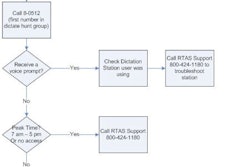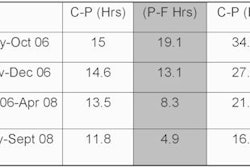It's challenging enough for a single medical practice or imaging center to keep track of patients who are overdue for a mammography screening. So how does a large, multifacility healthcare network with an enrollment of more than 150,000 patients accomplish this?
Massachusetts General Primary Care Network (MGPCN) of Boston created an enterprise-wide breast cancer screening outreach and intervention program called Mammography FastTrack.
Mammography FastTrack combines a Web-based IT application designed to identify patients overdue for healthcare services with automated and manual human intervention. Its development and initial six-month pilot are described by Dr. William Lester and colleagues at Massachusetts General Hospital's Laboratory of Computer Science in the Journal of the American Medical Informatics Association (March/April 2009, Vol. 16:2, pp. 187-195).
Mammography FastTrack consists of a core registry of patients who qualify for an annual or biannual mammography screening. Patients affiliated with six of the four community health centers and 10 hospital-affiliated practices of MGPCN that participated in the initial launch of Mammography FastTrack in 2006 were identified from data in electronic medical records (EMRs).
Mammography at-risk patients were identified based on patient demographic information from the hospital information system, dates of prior mammograms, scheduled mammograms from the radiology information system, visit notes, and payor billing and encounter claims. Patients were also associated with one of 64 primary care providers or, if the patient did not have a designated primary care provider, the practice center where the patient had received the majority of her care.
Once populated, the data in the registry were reviewed on a nightly basis, computer time-shared with other jobs by processing 10 patients at a time. The review determined which additional women had become overdue for mammography scheduling, or updated the subsequent patient or medical staff actions.
Women whose clinical and billing data indicated that they had not had a mammography screening in the past 24 months were defined as being at risk. In the first six months of operation, 3,054 patients were identified. The median age of the women was 53.7 years; 78% of the women were Caucasian, 7% were African-American, 5% were Hispanic, and 6% were Asian. Only 8% did not have insurance coverage, and 8% did not speak English as a primary language.
Fifty-five percent of these women were associated with a specific physician, and the remaining 45% were associated with a practice-based center. Participation by physicians and practices was strictly voluntary, but all six centers participated, as did 55 of 64 primary care physicians. The authors attribute a physician participation level that exceeded their objective of 75% to the fact that the registry associated patients with their caregiver at a 98% accuracy rate.
Each day, women identified as being overdue for a mammography screening were listed on a Provider Mammography Review Interface. When a physician or support staff moved a cursor over a patient's name in their individual list, a pop-up window would display the patient's name, primary language, contact information, data of last completed screening mammogram on record, date of next scheduled visit, and EMR health maintenance notes with information such as prior refusals or outside testing. Selecting a patient's name would open her MGPCN electronic medical record.
The medical staff then had the option to check a contact patient box or a defer box, the latter of which required selection of a deferral reason. These reasons included the scheduling or completion of a mammogram; that the patient had received a bilateral mastectomy; there was a record of informed refusal; or the patient was deceased, not eligible, or not the patient of the provider. Once an action was indicated, the patient's name was removed from the overdue list for a week, or, if appropriate, the name was removed permanently from the physician/practice affiliation or the registry itself.
A contact patient selection initiated the need to create a personalized letter that was processed by a central clerical team, and if the patient did not respond in a week, an alert to telephone the patient was sent to the primary care provider or the appropriate medical staff at the practice center. Easy-to-use data screens were created so that individuals telephoning patients could directly schedule a mammogram using a Web-based radiology order entry system, document telephone attempts, and add other notes, such as the patient saying that she had received or scheduled a mammogram outside the MGPCN diagnostic imaging facilities.
In addition to an accurate database registry, easy-to-use decision and notification software, personalized educational letters to the patient customized to physician/practice preference, and decisions on appropriate action made by clinical staff, Mammography FastTrack offered a single results reporting phone line, fax number, and mailing address for patients to respond directly to the notification.
So, how successful was the initial six-month pilot of Mammography FastTrack with respect to scheduling patients?
- Medical professionals screened 2,534 of the 3,054 patients identified, or 83% of the total.
- 2,167 patients were sent letters, of which 167 were returned as undeliverable.
- Of the 2,000 patients who received letters:
- 866 patients, or 43.3%, were scheduled for a mammogram by telephone with designated staff.
- 278 patients, or 13.9%, when telephoned said they responded to the reminder by scheduling a mammography screening at a non-MGPCN radiology department.
- 118 patients, or 5.9%, telephoned the MGPCN designated phone line to advise of outside mammograms or decline a screening.
- 686 patients were identified by staff as deferring the scheduling of a mammogram. Of this subgroup, 32.7% had completed or already scheduled mammograms, and 41% either did not have an accurate telephone number or could not be reached after three attempts.
The major limitation of the Mammography FastTrack program was that the patient registry itself could not have patients added or deleted from it once it had been created. Future implementations will correct this, as well as incorporate a method for tracking report results and an interactive interface for primary care physicians to edit their list of future patients, according to the authors.
But even with the limitation of a static patient population, it's commendable that 1,144 women who had overlooked their mammography screening for whatever reason responded to a notification generated by this innovative software and staff alert system.
By Cynthia E. Keen
AuntMinnie.com staff writer
March 13, 2009
Related Reading
AJR studies show decline in mammo use, workforce shortages, February 3, 2009
Telephone interventions encourage mammography adherence, February 2, 2000
Copyright © 2009 AuntMinnie.com



















